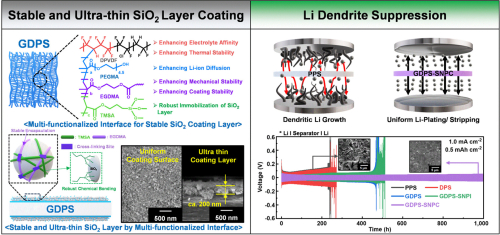Mechanical and thermal failure of a polyolefin separator often causes the internal short-circuit of batteries, which leads to abrupt heat generation in a short time, so-called thermal runaway. For this, we introduce grafting polymer layers with cross-linking to make a superior, thin, and uniform SiO2 layer with strong chemical binding to the surface of a polypropylene separator (PPS). The surface of the PPS was modified with i) coating of double bond-contained PVDF, ii) grafting with poly(ethylene glycol) methacrylate, 3-(trimethoxysilyl)propyl methacrylate, and ethylene glycol dimethacrylate, and iii) coating with SiO2 nanoparticles via immersing (GDPS-SNPI) or casting (GDPS-SNPC) methods.
The pore structure and distribution, electrolyte affinity, thermal stability, and mechanical properties were progressively improved after respective modification steps.
—Park et al.

Park et al.
The GDPS-SNPC cell showed excellent capacity retention of 100% at 1 C after 100 cycles and the lowest increase in the cell impedance, whereas an LFP half-cell with PPS exhibited capacity retention of 88.32%.
Furthermore, the team found that the coating method for SiO2 nanoparticles substantially influences the long-term cycling stability of Li-symmetric cells.
The GDPS-SNPC cell survived after cycling more than 1,000 h at a current density of 1 mA cm−2, whereas the GDPS-SNPI cell died before 500 h.
Post-mortem analysis of the cycled Li-metal surface shows that smooth Li-plating occurred at the GDPS-SNPC cell, presumably due to a high Li-ion transference number.
This work provides a solid methodology for producing a novel and robust separator and advances the understanding of separators’ impact on electrochemical and physical phenomena within the cell.
—Park et al.